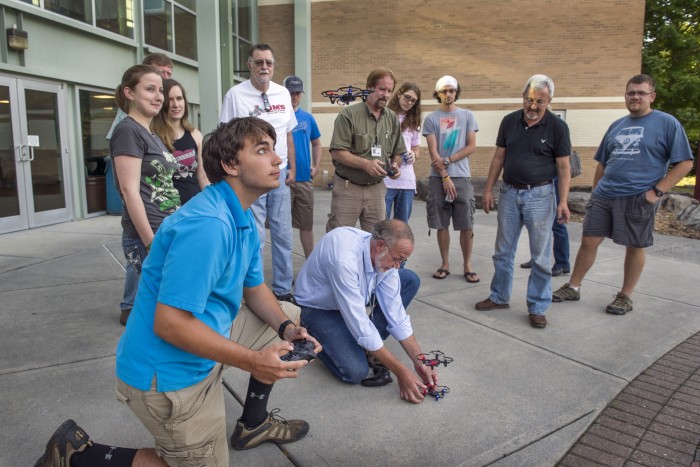Colleges Are Marketing Drone Pilot Courses, but the Career Opportunities Are Murky

Hot-air balloon pilot Richard Varney typically spends his weekends transporting tourists around central Massachusetts in a huge, multicolored balloon. But on a recent Sunday, Varney drove to a local community college and learned to fly a different type of aerial vehicle. “I want to try something new,” he said as he watched an instructor demonstrate how to steer a $2,000 drone equipped with a camera. “This could help me launch a side business taking aerial photos of local towns.”
Varney isn’t the only one betting on this as a new vocation. At least 15 community colleges across the country now have courses that teach people how to pilot drones, according to research conducted by MIT Technology Review. The trend accelerated over the past year, after the Federal Aviation Administration (FAA) issued a rule that requires people who operate drones commercially to take a test and get certified as “remote pilots.”
Some four-year colleges and private companies are also training people to be drone pilots, but the community-college programs are particularly interesting because they attract diverse types of students, including adults looking to change careers. In fact, many community colleges offer drone classes through their “workforce development” and “workforce solutions” departments, which are designed to impart practical skills that people can apply immediately to their jobs or use to get new jobs, rather than conferring credits toward a college degree.
It’s difficult to say whether these noncredit courses are effective. They vary in length from a single weekend to an entire semester and in cost from $130 to $1,250, are open to ages ranging from high schoolers to retirees, and typically lack a formal process for matching enrollees with jobs. None of the schools tracks the number of students who end up working with drones, nor does the FAA or the Association for Unmanned Vehicle Systems International (AUVSI), a trade group that represents the drone industry. But anecdotal data from community colleges helps explain why people are enrolling in these programs, what they learn, and how they plan to use their new skills.

For example, a September course at Quinsigamond Community College in Worcester, Massachusetts, attracted nine students: Varney, the hot-air balloon pilot; some other people interested in using drones for photography and videography; two police officers; and one firefighter. The weekend class consisted of one day of indoor preparation for the FAA exam, which is a two-hour, 60-question test, and one day of flight training, which involved maneuvering a 7.5-pound drone made by the Chinese company DJI around the school’s parking lot. Nearly all of the participants said they planned to take the FAA test at some point in the future; the emergency-services workers so they could fly drones for search-and-rescue and to document serious traffic accidents, and the others to snap photos and videos of real-estate properties and inspect infrastructure, such as bridges, according to class instructor Michael Bush.
Tulsa Community College, Dabney S. Lancaster Community College in Clifton Forge, Virginia, and Sauk Valley Community College in Dixon, Illinois, also say their ongoing drone classes are a mix of people who want to acquire skills for their current jobs; take a second, part-time job; change jobs; or start new ventures.
All of these community colleges began offering drone classes this year. Administrators and instructors who spoke to MIT Technology Review characterized their programs as a response to community demand rather than an attempt to jump on a fad. “We think [drones] are going to have wide implications for a variety of industries and it’s better to prepare people for that disruption than to say we don’t need to worry about it,” says Kathleen Manning, the dean of Quinsigamond Community College’s Center for Workforce Development and Continuing Education.
The FAA estimates the number of certified U.S. drone pilots will grow from 107,800 in 2017 to 422,000 in 2021. However, the agency does not specify how many of those pilots will be paid for their work. A spokesperson said the FAA had issued more than 63,000 remote pilot certificates to date.
AUVSI, the U.S. trade group, predicts that the drone industry will create 50,529 direct jobs between 2015 and 2025. Bijan Vasigh, an economics and finance professor at Embry-Riddle Aeronautical University who helped calculate those figures for AUVSI, acknowledges that many drone-related jobs will require specialized technical degrees. But he also considers community colleges ideal places to teach people elementary skills related to flying, fixing, and monitoring small drones. “Learning how to operate a drone or simple drone logistics can certainly be done in a certification program,” he says.
In the absence of hard data, community colleges that have offered drone training for several years may provide the clearest measure of these programs. Since 2015, Fred Coeburn has taught more than 100 students how to operate small drones at Mountain Empire Community College in Big Stone Gap, Virginia. His classes aim to train both young people and older workers displaced by the decline of the local coal, textile, and tobacco industries to be drone operators/technicians. Coeburn says the goal was to create a ready, willing, and affordable labor pool that would lure drone-related companies to the area—but the region still has more job seekers than jobs.
“We have received many promises [from companies] … but so far none of them have come to fruition,” he says. “We’re in a ‘Catch-22’ phase … new industry won’t move here unless there is a trained or rapidly trainable workforce, but it’s also hard to justify training students for jobs that are [only] promised in the future. [Still,] if I get one person a job who didn't have one before, I'm making headway.”
Keep Reading
Most Popular
Large language models can do jaw-dropping things. But nobody knows exactly why.
And that's a problem. Figuring it out is one of the biggest scientific puzzles of our time and a crucial step towards controlling more powerful future models.
The problem with plug-in hybrids? Their drivers.
Plug-in hybrids are often sold as a transition to EVs, but new data from Europe shows we’re still underestimating the emissions they produce.
Google DeepMind’s new generative model makes Super Mario–like games from scratch
Genie learns how to control games by watching hours and hours of video. It could help train next-gen robots too.
How scientists traced a mysterious covid case back to six toilets
When wastewater surveillance turns into a hunt for a single infected individual, the ethics get tricky.
Stay connected
Get the latest updates from
MIT Technology Review
Discover special offers, top stories, upcoming events, and more.